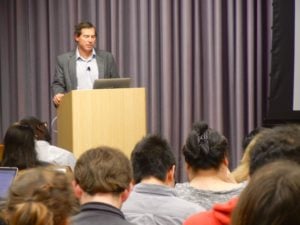On the eve of the election, three speakers analyzed the economic reasons behind Trump’s popularity and focused on issues regarding inequality brought up by this year’s presidential race.

The event was part of the CSRE 12/112: “Presidential Politics: Race, Gender, and Inequality in the 2016 Election” class’s weekly discussions on race, gender and inequality for the 2016 election. The panel consisted of David Grusky, director of Stanford Center for Poverty and Inequality, Dominique Apollon, research director at Race Forward, and Sean Reardon, a professor of inequality in education .
Grusky stated that viewing issues of inequality from the lens of “rent” is important. In economics, rent is the payment to a factor of production in excess of what is required to keep that factor in its present use — for example, a person paid $100,000 in a current job, who would stay in that job for any salary over $80,000, is making $20,000 in rent. Rents give economists a way to talk about how our economy deviates from an ideal market and generally occur when workers are paid above the value of what they produce.
Grusky suggested that, in the past, many white factory workers were paid for more than the value of their work due to lack of competition from women, foreign countries and minority groups. He concluded that their declining income in recent times helps fuel the populist movement for Donald Trump.
“Folks who are beneficiaries may not see it as rent,” Grusky said. “In the past it was a fair return, and now it is a ‘rigged system’ taking it away.”
Apollon presented on issues of racism and institutional challenges that people of color face in everyday work environments. His work indicates that anti-discrimination laws, such as Title VII of the 1964 Civil Rights Act, often are ineffective and cumbersome for workers. Apollon advocates instead for a more proactive approach at addressing discrimination.
Though pundits may point to Obama’s presidency as proof that discrimination ceases to exist, Apollon disagrees.
“Hitting one important milestone did not get rid of barriers in other areas,” Apollon said.
Reardon used various metrics, such as the probability of attending elite colleges, performance gaps and percentage of students in high poverty schools, in order to illustrate racial and economic inequality. He stressed a holistic approach to education reform, making changes from pre-kindergarten all the way to the college level.
After lamenting the little attention given to education during the campaign, Reardon used the pushback by certain states against the Common Core State Standards Initiative to demonstrate the difficulty of centralized education reform.
The panelists acknowledged that the next president would face political challenges in addressing these concerns. Grusky cautioned that since beneficiaries of the current system perceive it as fair, there will be significant opposition to egalitarian reforms.
“If we commit in an authentic way to equal opportunity … it would mean that we would better explore talents and capacities of our people, have a much more vibrant economy, and that kind of equalizing reform would parlay into economic growth,” Grusky said.
Contact Jackson Lallas at jlallas ‘at’ stanford.edu.